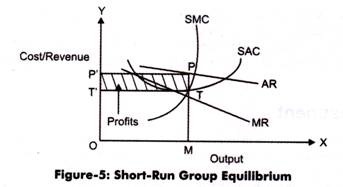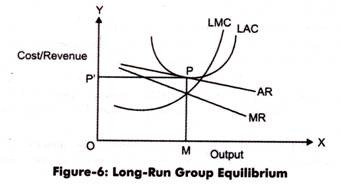The equilibrium of an individual organization under monopolistic competition.
However, in monopolistic competition, it is necessary for an organization to analyze price and output of other organizations existing in the industry.
The price-output equilibrium of all organizations is known as group equilibrium.
The concept of group equilibrium was introduced by Chamberlin. Group equilibrium represents the price and output of organizations having close substitute. However due to product differentiation, it is difficult to form market demand schedules and supply.
ADVERTISEMENTS:
For overcoming the problem Chamberlin gave a concept called product group, which includes products that are technological and economic substitute of each other. Technological substitutes are the products having technical similarity, while economic substitutes are the products that have same prices and fulfill the same want of consumers.
In technical terms, product group refers to a group in which the demand for each product is highly elastic. This is because in the product group, the demand for a product changes with the changes in the prices of other products within the group. Therefore, the price and cross elasticity of demand for products forming the group is high.
In an industry, different types of groups exist automatically. For example, the automobile industry comprises various groups on the basis of product type. In such an industry one group manufactures cars and the other produces trucks.
However, the main competition would be among those organizations manufacturing similar products (cars or trucks) as they are close substitutes of each other. Due to product differentiation, there is a large variation in the demand and cost curves of organizations. Consequently, the price, output, and profits of organization also differ from each other.
ADVERTISEMENTS:
Therefore, to simplify product group analysis, Chamberlin has given two assumptions, which are as follows:
i. He assumed that the demand and cost curves of all products forming the group are the same or uniform. This assumption is termed as uniformity assumption. According to this assumption, the preferences of consumers are evenly distributed and the difference in preferences is not that much to give rise to variation in cost.
ii. He also assumed that in monopolistic competition, a large number of sellers are not able to influence each other’s decisions. This implies that if an organization makes changes in prices or level of output, this would have insignificant influence on its competitors. Such type of an assumption is termed as symmetry assumption.
These two assumptions form the basis for group equilibrium analysis. If an organization within the group has established a popular brand, it is more likely to earn supernormal profits. However, in the long run, other organizations would strive to emulate the product design and features. In such a case, supernormal profits would vanish.
ADVERTISEMENTS:
This is a general case of all monopolistically competitive organizations. On the other hand, if the entire group is earning supernormal profits, then external organizations would get attracted toward the group, until the legal or economic barriers are imposed.
Figure-5 shows the short-run group equilibrium:
In Figure-5, P is the equilibrium point at which output is OM, price is MP, and average cost is MT. In such a case, marginal cost is equal to marginal revenue. Therefore, organizations are earning supernormal profits (P’PTT’). However, these supernormal profits disappear in the long run.
Figure-6 shows the long-run group equilibrium:
In Figure-6, it can be seen that the supernormal profits are disappeared. Figure-6 also depicts that average revenue (AR) is tangent to LAC, which implies that price is equal to average revenue. Marginal revenue gets equal to marginal cost at the output level of OM. This shows that in the long run, all organizations in the industry are making normal profits.

